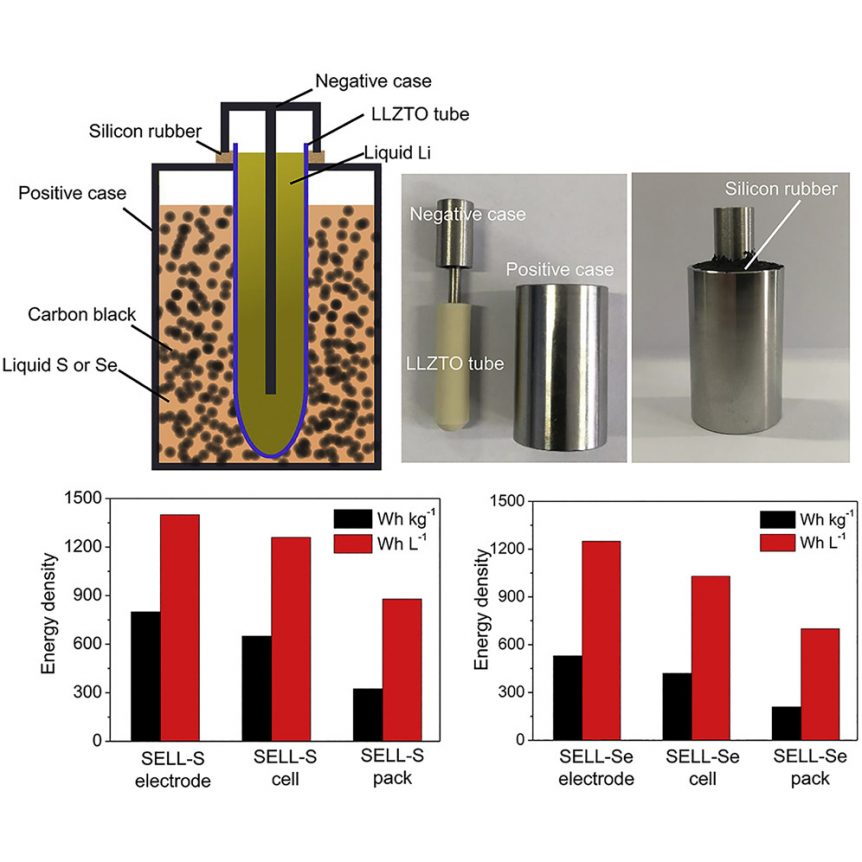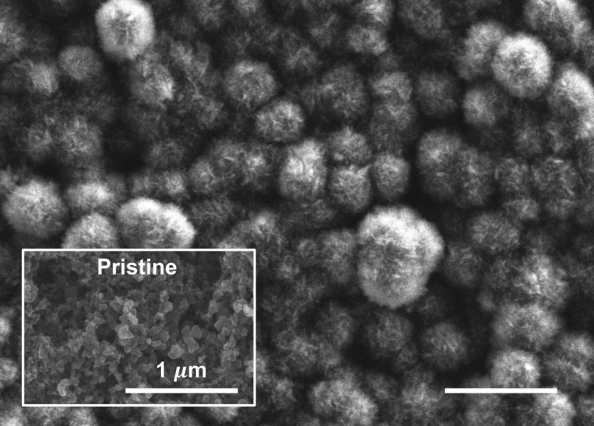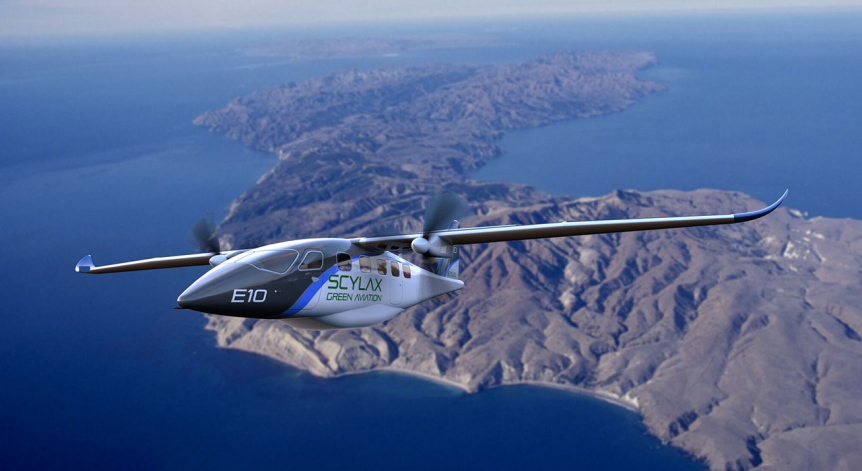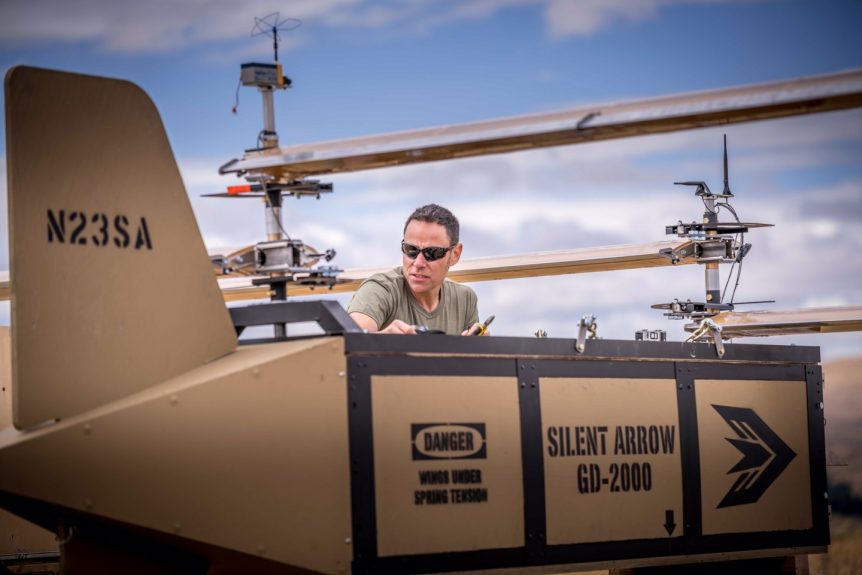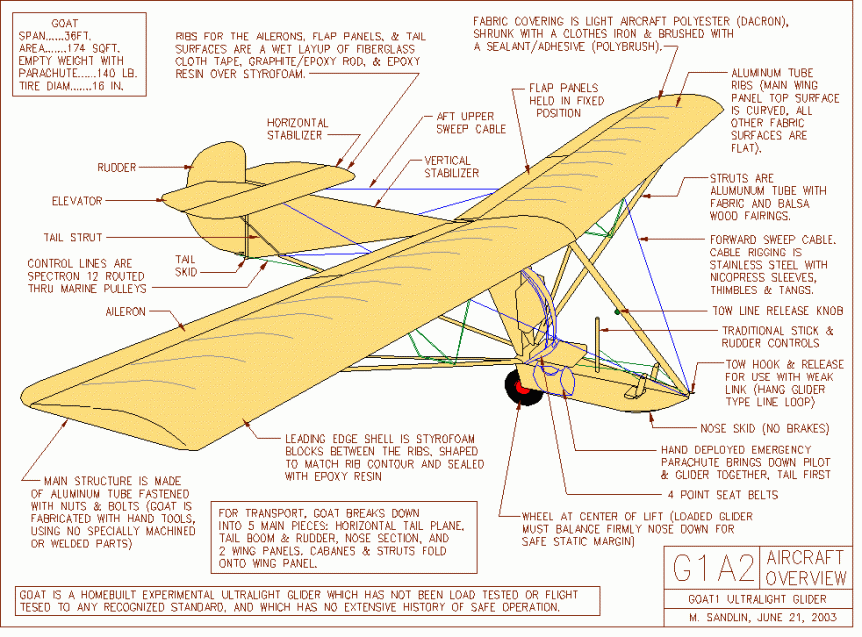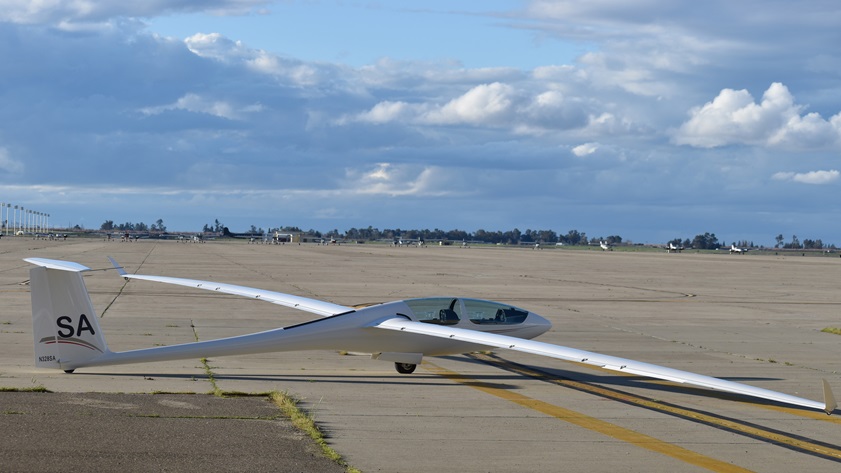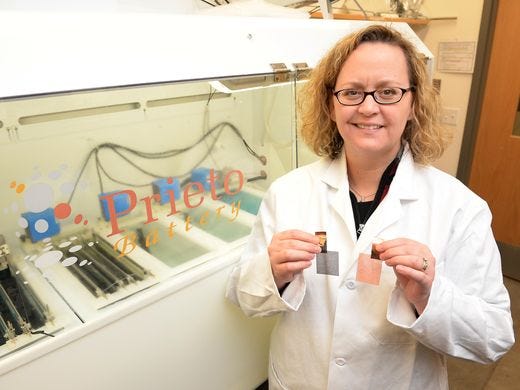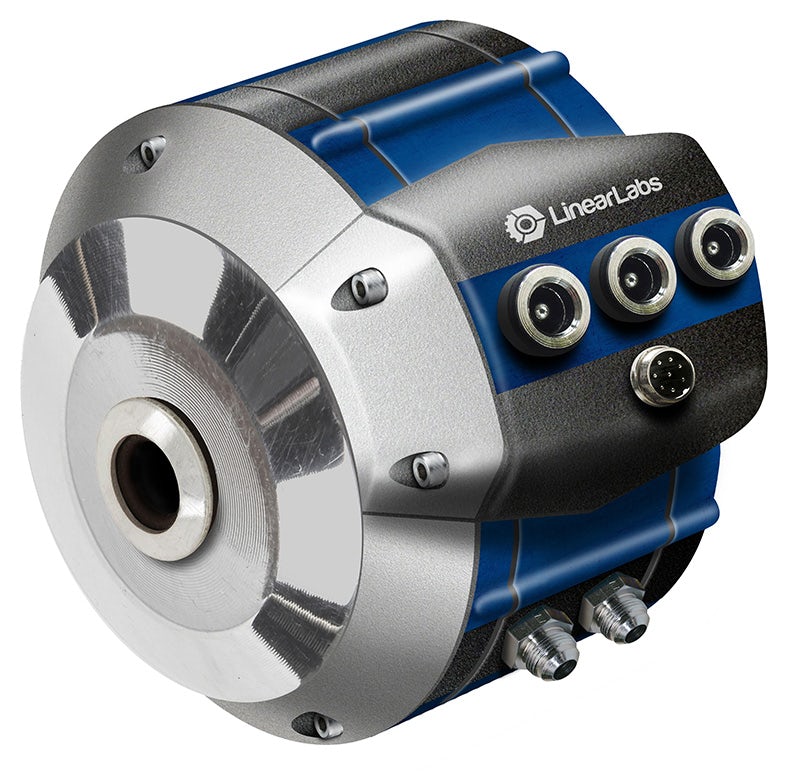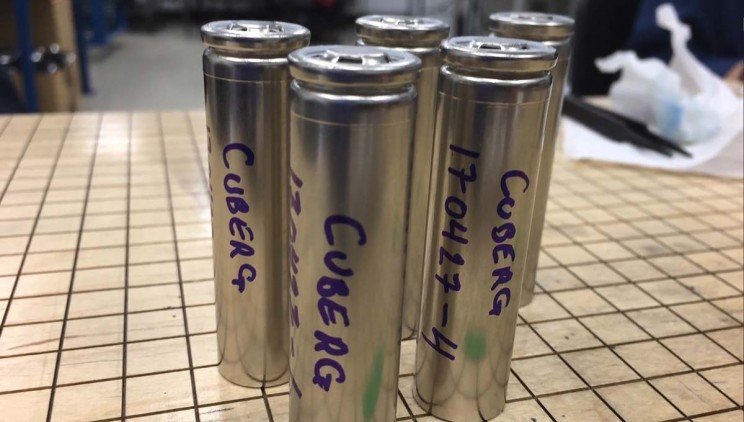In battery making, recipes for electrolytes play an important part of the whole. In a new formula whipped up by Zhengzhou University, Tsinghua University and Stanford University, Lithium (Li), Lanthanum (La), Zirconium (Zr), Tantalum (Ta), and Oxygen (O) form a ceramic tube as the battery’s electrolyte. This tube is centered in new solid state Lithium Sulfur and Lithium Selenium batteries. Researchers filled that tube with a liquid lithium electrode, and immersed the tube in a bath of carbon black and liquid selenium or sulfur in a stainless steel container. The team’s paper, “High Energy-Density Solid Electrolyte-Based Liquid Li-S and Li-Se Batteries,” published in the October 15 edition of Joule, explains the new batteries should be capable of delivering energy densities of around 2,600 Watt-hours per kilogram for the lithium-sulfur chemistry and 1,160 Wh/kg. for lithium-selenium. Currently, researchers have achieve 500 Wh/kg, double the best Li packs today. This can be achieved at cost of $41 per kilowatt-hour for the Li-Se …
Charging Carbon Dioxide Batteries and Clearing the Air
We would love to find ways to reduce carbon dioxide as a threat to our climate with an ever-decreasing timeline for accomplishing that task. University of Illinois at Chicago and Massachusetts Institute of Technology (MIT) have made inroads into creating a carbon dioxide battery that uses CO2 as an energy storage component. Amin Salehi-Khojin, associate professor of mechanical and industrial engineering at UIC’s College of Engineering, explains, “Lithium-carbon dioxide batteries have been attractive for a long time, but in practice, we have been unable to get one that is truly efficient until now.” A 7X Battery The incentive to use CO2 comes from lithium-carbon dioxide batteries having a specific energy density more than seven times greater than conventional lithium-ion cells. Unfortunately, until now, Li-CO2 batteries haven’t been rechargeable – at least for a reasonable number of cycles. Now, researchers at the University of Illinois at Chicago have demonstrated, “lithium-carbon dioxide batteries can be designed to operate in a fully rechargeable …
Scylax E10: Electric Flight Over the North Sea
A joint venture between the East Frisian FLN airline (FLN FRISIA-Luftverkehr GmbH Norddeich) and Munich aircraft manufacturer Scylax GmbH has helped expand the success of two “clean-sheet” designs, the E6 and E10. Both are promised to China Blue Airlines, and their first-time sale to a German-based airline will help ensure economies of scale for production. Short Runs with no Range Anxiety FLN already operates 10 BN-2 Norman Britten Islanders and a few Cessna 172s and 182s. The Islanders would be replaced over time by E10s. As one can imagine, The North Sea and limited airports make special demands on aircraft, including being able to take off and land in 300 meters (984 feet) and manage 40 knot (46 mph) crosswinds , as depicted in the videos of Norman Britten Islanders landing on the airport at Nordern. Electric craft should have even better performance. Founded in 1969 to supplement shipping traffic to the East Frisian islands of Juist and Norderney, FLN Frisia-Luftverkehr GmbH …
A Boxy (Motor) Glider That Delivers
Chip Yates used the same UQM motor on his record-breaking Pikes Peak and Bonneville Salt Flats motorcycle and his modified Long-Eze aircraft (Long-ESA for Electric Speed and Altitude). He planned an ekectric trans-Atlantic flight using an audacious concept for mid-air recharging. A bit quiet for the last several years, Chip has come up with a boxy glider, a load carrier that will, at some point, use the same kind of UQM motor with which he set so many records. The Silent Arrow GD-2000 Capable of hauling 907 kilograms (2,000 pounds) to front-line troops, or emergency supplies to otherwise inaccessible disaster zones, the GD-2000 Silent Arrow allows delivery of heavy cargo from a range of aircraft and helicopters. Yates Electrospace lists the following specifications for the GD-2000. Gross Weight: 2,000lbs (907 kg) -Cargo Weight: 1,631lbs (740 kg) Cargo Volume: 26cu/ft (.75 cu/m) Glide Ratio: 8.4:1 Stall Speed @1,000lbs: 62kts, @2,000lbs: 92kts Standoff: 40 miles Logistics: 28ft wingspan (4 spring-deployed wings) stowed …
Electric Flight for the Masses
Paracas, Peru lies on the South American country’s Pacific coast, halfway between Ecuador and Colombia to the north and Chile to the south. There, Alex Ferrer has built a Super Goat ultralight glider and powered it with a Chinese motor, controller and batteries for electric flight. Since he displays in-flight data on his videos, one can get an appreciation of the small amount of energy required to keep a very light machine like the Mike Sandlin craft in the air. Sandlin makes plans for his gliders available for free on line. Excellent drawings with high-grade details, they enable a committed craftsman the ability to use simple hand tools to make a glider that one can carry atop a compact car and go flying for as long as one can enjoy. One can choose a Goat monoplane, BUG (Basic Ultralight Glider) biplane, or Bloop powered biplane. According to Sandlin’s web site, the gliders share the following characteristics: Folding wing design provides …
Tehachapi Soars with New ideas
Every year, Labor Day weekend brings sailplane enthusiasts to Jeff Byard’s hangar on Mountain Valley Airport above Tehachapi, California. It’s a friendly get-together that always has challenges and surprises for the participants. History on the Field This year, attendees were treated to an opening talk by Jeff Byard titled “Soaring, Something for Everybody.” It lived up to its name, with a review of sailplanes of all types, with many examples right in the presentation hangar. For history buffs, jeff’s hangar, and Doug Fronius’ a few doors away, offer a glimpse of every type of hand-made soaring machine, including Doug’s recreation of Waldo Waterman’s 1911 hang glider, something which has been flown over the California coast. Jeff’s collection includes a Slingsby SG-38 primary glider and T-21 side-by-side trainer (seen above in its native habitat, England). The T-21 fuselage rests on the floor to the right as one opens the hangar doors, and the wings in mid-restoration hang nearby. Jeff hopes to …
The Prieto Battery Receives Affirmation
Dr. Amy Prieto created her namesake battery a decade ago, and has been seeking funding and other support for its development ever since. It gained such funding from Stanley Ventures in 2016. Prieto Battery, as reported by GreenCarCongress.com then, is, “A company commercializing a 3D Lithium-ion battery technology (earlier post), announced a strategic investment from Stanley Ventures, the venture arm of Stanley Black & Decker, a world-leading provider of tools and storage, commercial electronic security and engineered fastening systems.” Possibly more important that money, Dr. Prieto’s battery recently received third-party validation of its claimed safety and performance attributes from Energy Assurance, LLC. GreenCarCongress reports, “Specifically, Prieto had a group of fully assembled batteries containing their proprietary 3D anode tested against an array of UL (Underwriters Laboratories) and IEC (International Electrotechnical Commission) standards for Li-ion chemistry. All of Prieto’s batteries had 100% success rate with zero failures.” Dr. Prieto seems happy with these results, stating, “These results validate the science and manufacturing …
HET: Quadrupling the Flux, Quintupling the Torque
Linear Laboratories operates (if you take their video at near face value) out of a barn in Texas and partners with Abtery in Sweden. The partnership is significant, since Abtery is working on a Swedish regional airliner Elise (“Elektrisk Lufttransport i Sverige” or Electric Aviation in Sweden). The project is funded by the Swedish innovation agency Vinnova. And has multiple partners including Chalmers University. Their goal is to apply the HET (Hunstable Electric Turbine) technology developed by Linear to real-world uses. Swedish Partners Anders Forslund, researcher at Chalmers in Gothenburg, Sweden, leads the development project Elise. “We started a little later than they did in other countries but now we’re up and running probably faster than they do. Intensive research is ongoing around the world for a transition from fossil fuels to electric power in aviation, especially in countries such as the United States, China and Germany. It’s all about small start-up companies to big aircraft manufacturers like Boeing.” Sören Granath of Swedish Radio …
Phosphorene Nanoribbons may Enhance Batteries, Solar Cells
A great deal is made of how many great scientific discoveries are made by accident for everything from penicillin to Post-its®. With no fewer than ten authors for the Nature letter “Production of phosphorene nanoribbons,” their discovery hardly seems “accidental.” The letter, authored by Mitchell C. Watts, Loren Picco, Freddie S. Russell-Pavier, Patrick L. Cullen, Thomas S. Miller, Szymon P. Bartuś, Oliver D. Payton, Neal T. Skipper, Vasiliki Tileli and Christopher A. Howard, explains their happy “accident.” A Happy Accident “Nanoribbons, meanwhile, combine the flexibility and unidirectional properties of one-dimensional nanomaterials, the high surface area of 2D nanomaterials and the electron-confinement and edge effects of both. The structures of nanoribbons can thus lead to exceptional control over electronic band structure, the emergence of novel phenomena and unique architectures for applications.” The discoverers of phosphorene nanoribbons were trying to separate layers of phosphorus crystals into two-dimensional sheets, but they ended up with “tiny, tagliatelle-like ribbons one single atom thick and only 100 atoms of so across, but up to 100,000 …
Cuberg Battery Flies 70 Percent Longer
Cuberg’s recent test between their battery and a conventional lithium-ion battery resulted in the Cuberg battery keeping a drone flying 70-percent longer. Given that the test is for two packs of equal weight, the result is an impressive one. Cuberg’s co-founder and CEO has prepared for this success since his undergraduate days as a SURF (Summer Undergraduate Research Fellowship) Fellow, putting his summer vacations to good use. He used the knowledge and experience he gained in three summer fellowships to help lead a dozen students “to design and develop innovative and efficient mechanical systems (including HVAC, hot water, insulation, appliances, and more) for the Solar Decathlon net-zero house competition.” The team won first place in the hot water contest and second place in the engineering contest in the Decathlon. Since then, he worked as an intern at Tesla Motors, using “physical, chemical, and electrochemical characterization techniques to study the degradation mechanisms of Li-ion batteries at the Cell Research Lab.” This led …

